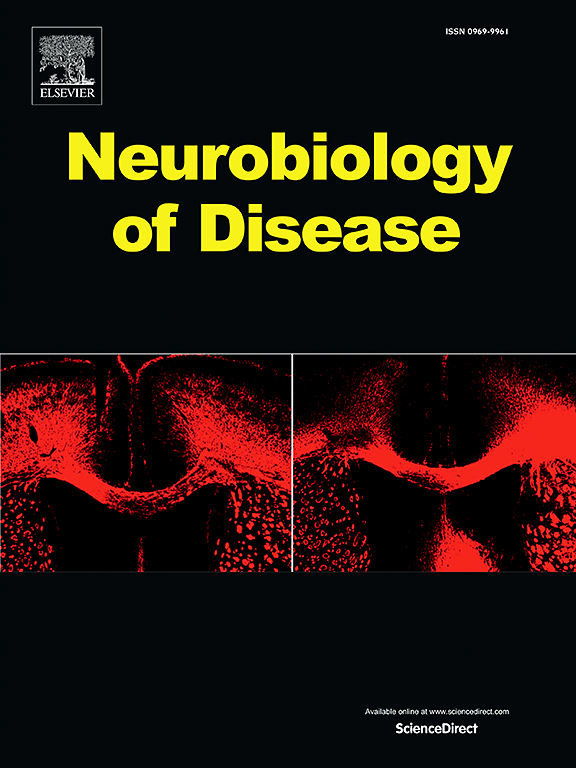局灶性到双侧强直阵挛性癫痫病变的脑连通性区域与基因表达相关。
IF 5.1
2区 医学
Q1 NEUROSCIENCES
引用次数: 0
摘要
局灶性至双侧强直阵挛性发作(FBTCS)是最严重的发作形式之一。为什么某些脑区的病变会导致FBTCS,而其他脑区的病变则不会?本研究旨在检测引起FBTCS的病变位置是否映射到特定的脑区,并探讨特定脑区与基因表达之间的相关性。对25例确诊为FBTCS的患者进行回顾性研究。采用病变网络映射方法,利用静息状态fMRI扫描的大型数据库来检测与引起FBTCS的病变相连的大脑区域。此外,使用转录组神经成像关联分析检查了与FBTCS特定脑区域相关的基因表达谱。FBTCS的病变位置是不均匀的,但与特定的大脑区域相连。小脑、丘脑、扣带皮层和额叶中回被确定为特定大脑区域的中枢,因为它们是96% %的病变在功能上连接的区域,并且在连通性上有显著差异。此外,在突触功能、离子通道活性、溶酶体和共病途径等生物学过程中,特定脑区与全脑基因表达共定位。本研究表明,导致FBTCS的病变映射到特定的大脑区域,为FBTCS的因果神经解剖学基础提供了见解。通过转录组学解码FBTCS的特定脑区可能提示FBTCS存在多尺度相互作用,促进我们对FBTCS的遗传分子机制的理解。本文章由计算机程序翻译,如有差异,请以英文原文为准。
Brain connectivity regions of lesions causing focal to bilateral tonic-clonic seizures correlates with gene expression
Focal to bilateral tonic-clonic seizures (FBTCS) is one of the most severe forms of seizures. Why lesions in some brain areas result in FBTCS while lesions in other areas do not? This study aimed to examine whether the locations of lesions causing FBTCS were mapped to specific brain regions and to explore correlation between the specific brain regions and gene expression. A retrospective study was conducted involving 25 patients diagnosed with FBTCS. The lesion network mapping method was employed, utilizing a large database of resting-state fMRI scans to detect brain regions connected to lesions causing FBTCS. Additionally, gene expression profiles related to the specific brain regions of FBTCS were examined using transcriptome neuroimaging association analysis. The lesion locations of FBTCS were found to be heterogeneous, but connected to the specific brain regions. The cerebellum, thalamus, cingulate cortex, and middle frontal gyrus were identified as hubs of the specific brain regions as they were the areas that were both functionally connected to 96 % of lesions, as well as significantly different in connectivity. Moreover, the specific brain regions were colocalized with whole-brain gene expression in the biological processes with synaptic functions, ion channel activity, lysosome and comorbidity pathway. This study suggests that lesions causing FBTCS mapped to the specific brain regions, providing insight into the causal neuroanatomical foundation in FBTCS. Decoding the specific brain regions of FBTCS through transcriptomic may indicate the presence of multiscale interactions in FBTCS, promoting our understanding of the genetic molecular mechanism of FBTCS.
求助全文
通过发布文献求助,成功后即可免费获取论文全文。
去求助
来源期刊

Neurobiology of Disease
医学-神经科学
CiteScore
11.20
自引率
3.30%
发文量
270
审稿时长
76 days
期刊介绍:
Neurobiology of Disease is a major international journal at the interface between basic and clinical neuroscience. The journal provides a forum for the publication of top quality research papers on: molecular and cellular definitions of disease mechanisms, the neural systems and underpinning behavioral disorders, the genetics of inherited neurological and psychiatric diseases, nervous system aging, and findings relevant to the development of new therapies.
 求助内容:
求助内容: 应助结果提醒方式:
应助结果提醒方式:


